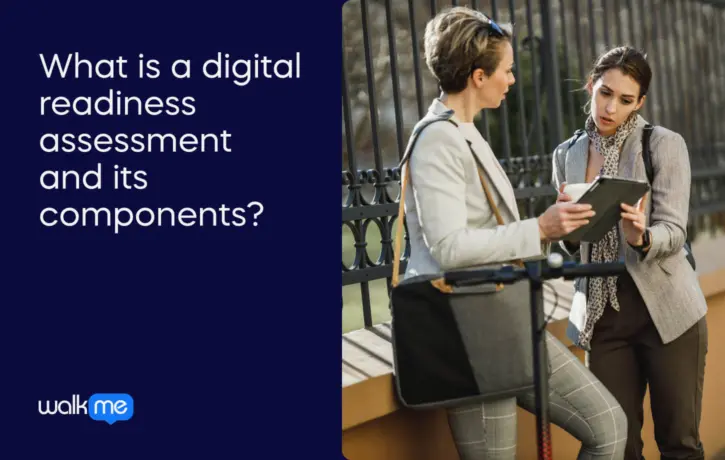An organization can only progress if it can identify its strengths and weaknesses.
A digital readiness assessment helps an organization understand whether it is ready to enter the digital world or needs to make extra preparations first to achieve this, whether as part of a few change initiatives or a full-scale digital transformation.
The assessment must answer the question: Does your business strategy work in a digital world? It assesses your business strategy, leadership, culture, and the digital tools of your tech stack.
Global spending on digital transformation has never been higher, and expectations suggest it will reach USD 3.4 trillion by 2026. You may be left behind if you don’t invest in a digital readiness assessment to prepare yourself for the digital future.
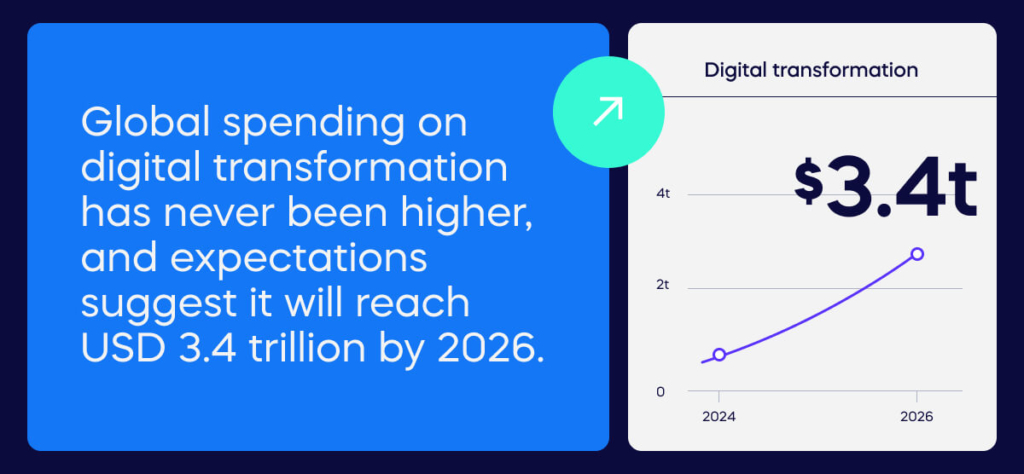
This article will explore the digital readiness assessment, providing insights into its definition, the crucial role of digital readiness analysis, the process of completing an assessment, its key components, the significance of the digital readiness score, and an examination of the five types of readiness.
What is the digital readiness assessment?
The Digital Readiness Assessment (DRA) allows organizations to gauge their preparedness for success in the digital era.
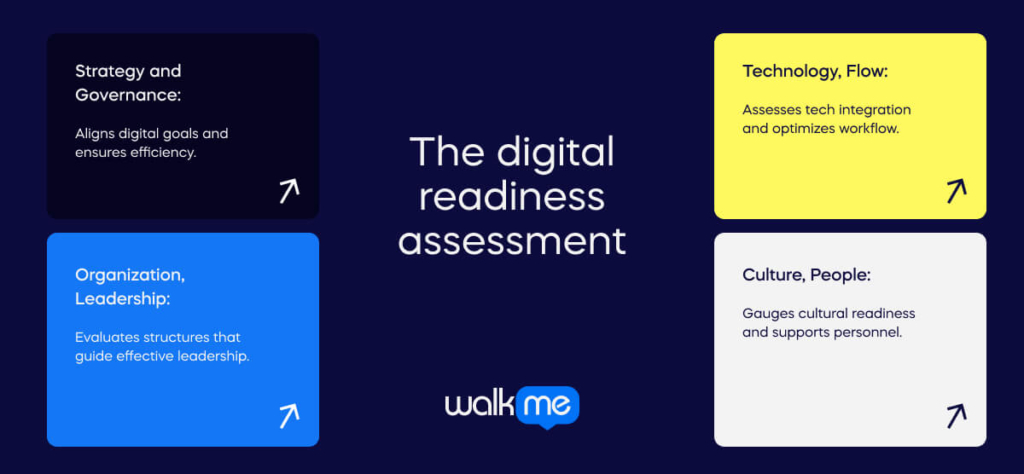
It assesses their current state across four foundational dimensions:
- Strategy and Governance: Aligns digital goals and ensures efficiency.
- Organization, Leadership: Evaluates structures that guide effective leadership.
- Technology, Flow: Assesses tech integration and optimizes workflow.
- Culture, People: Gauges cultural readiness and supports personnel.
Why is digital readiness analysis crucial?
Without digital readiness analysis, another name for digital readiness assessments (DRA), companies would invest heavily in technologies for which they have insufficient preparation and waste massive resources.
A DRA helps enterprises communicate digital transformations to staff before implementing them and ensure that processes undergo adequate adjustment in readiness for the new technology.
This process ensures that digital transformations and change initiatives thrive as the organization is ready, increasing ROI and reducing waste and employee retention as stress and burnout stay low.
The 4 components of a digital readiness assessment
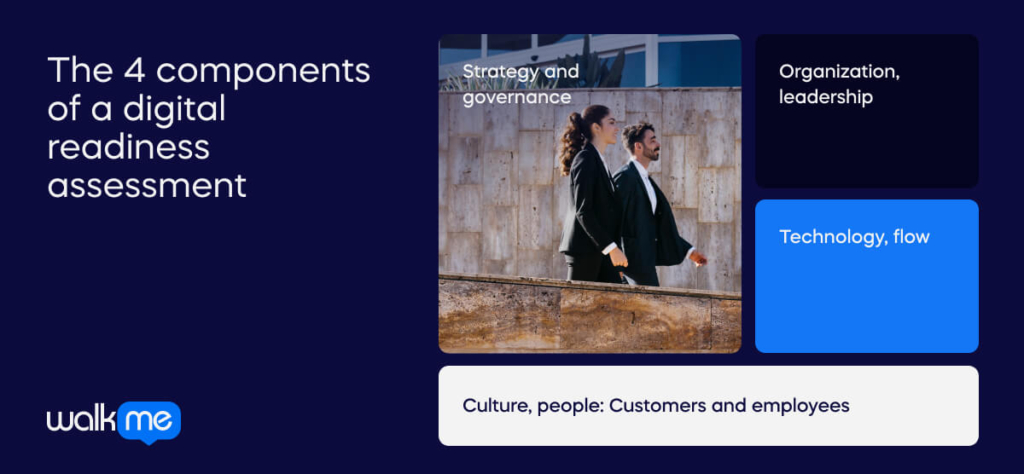
There are four components of a digital readiness assessment. Cover each of these in detail to ensure a successful and comprehensive assessment of your current enterprise’s state of strategy, organization, tech stack, and culture.
Covering each area in as much detail as your resources allow will give you a complete picture of your digital readiness, which you can use to work toward digitization.
- Strategy and governance
Strategy and governance are cornerstones in digital readiness, shaping an organization’s transformative journey. A well-crafted strategy ensures that digital initiatives align seamlessly with overarching business goals, providing a roadmap for effective implementation.
Conversely, governance establishes the necessary controls, compliance measures, and risk management protocols, creating a secure foundation for digital endeavors. These elements collectively steer the organization toward a future-ready state, anticipating technological shifts and fostering adaptability.
Strategic foresight and robust governance frameworks empower organizations to navigate the digital landscape confidently, fostering innovation, digital resilience, and sustained growth in an era of technological dynamism and evolving market demands.
- Organization, leadership
Evaluating the digital maturity of organizational structure and existing expertise is crucial. The success of a digitalization strategy hinges on firmly embedding the digitalization issue within a company’s organizational approach.
Leadership is one of the critical elements to the success of any digital readiness campaign, but it is a challenge to achieve. Although 78% of leaders try to engage with their staff, only 48% of employees feel that their leadership is high quality. However, the quality of leadership is imperative to digital readiness success.
The digital readiness process introduces relevant roles and responsibilities, such as a Chief Digitalization Officer (CDO). Equally important is cultivating diverse digitalization knowledge in a cross-functional, cross-country manner. Analyzing the company’s digital maturity level is pivotal in this context.
- Technology, flow
Evaluating the level of digital maturity concerning technologies employed in core functions is vital, and you can accomplish this through a digital audit. Here, technologies are facilitators for digitalization.
Employing a cross-functional perspective, encompassing aspects from accounting to sales to internal communication, ascertain the current utilization of digital technologies and identify areas with deficiencies or a requirement for intervention.
A technologically adept workforce, coupled with optimized workflows, accelerates the pace of digital adoption. It enables organizations to harness the full potential of digital tools, respond swiftly to market changes, and meet evolving customer expectations.
The harmonious interplay between technology and workflow is instrumental in cultivating a digitally ready environment, empowering organizations to thrive in the ever-evolving digital landscape.
- Culture, people: Customers and employees
Workplace culture encapsulates how staff complete tasks—the amalgamation of formal and informal systems, behaviors, and values that shape employee and customer experience.
Fundamentally, it defines the operational ethos within the workplace, encompassing both formal systems and informal behaviors of customers and employees.
Customers
Assessing the digital maturity of customers (groups) involves identifying the (digital) customer needs that staff must address. Effective digitalization is steered by market dynamics and customer experience, particularly in sales and client relationship management, where customer engagement is critical to success.
Employees
Employee digital readiness is the readiness to embrace digital transformation, involving creating new business models through technology. An engaging, digital-ready culture can benefit productivity, as engaged employees are 202% more productive than non-engaged staff.
A digital-ready requires adapting to complex digital tools, reshaping the company’s logic, and influencing daily tasks. Cultivating this readiness is crucial for successful digital transformation.
How do you complete a digital readiness assessment?
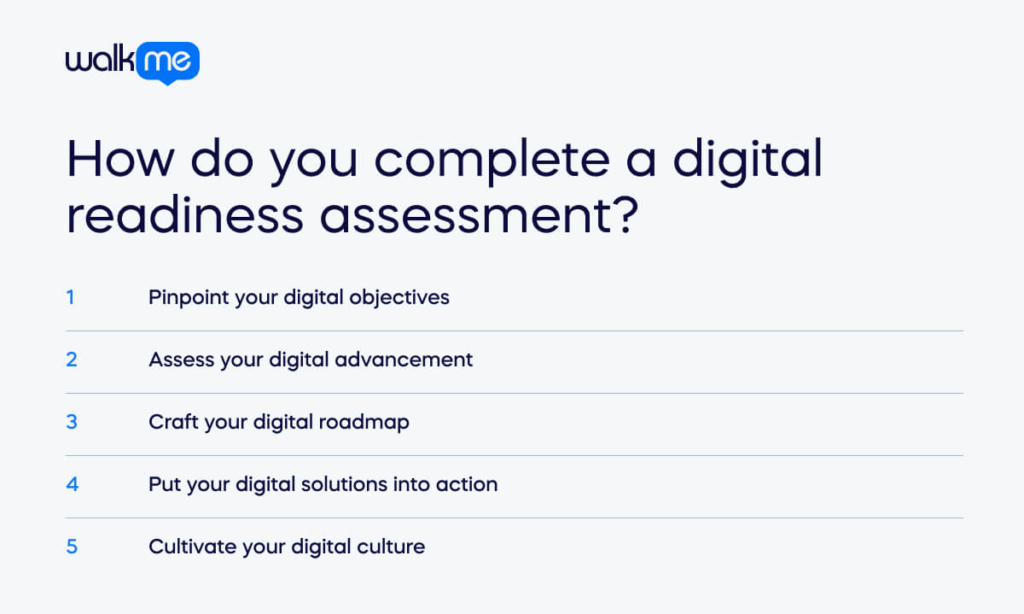
Follow this simple process to achieve an accurate and detailed digital readiness assessment that will allow you to understand your current state and form a plan for achieving digitalization.
Pinpoint your digital objectives
The initial phase involves outlining your aspirations for digital transformation and innovation. Clearly define strategic objectives, customer expectations, and competitive advantages. Align digital initiatives with your business vision and values.
Establish metrics for gauging digital performance and impact.
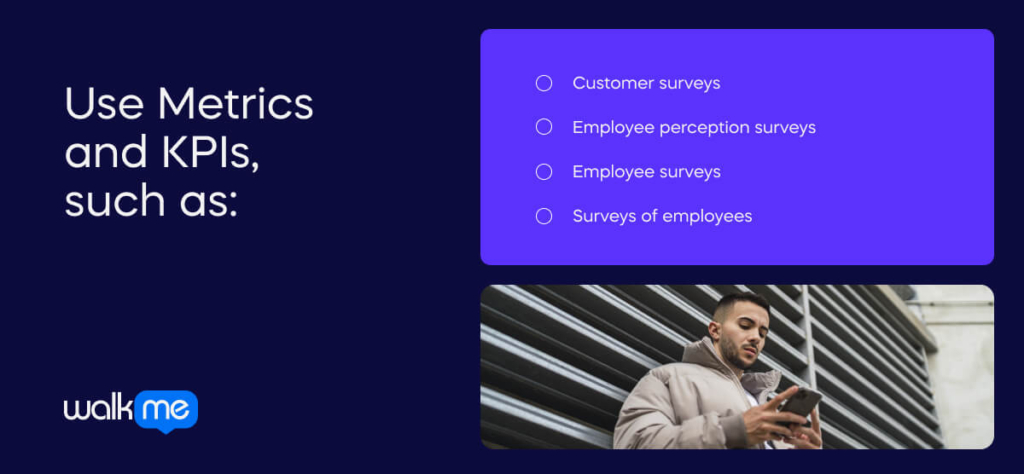
Use Metrics and KPIs, such as:
- Customer surveys that assess satisfaction levels with current and new technology.
- Employee perception surveys for current and new technologies.
- Employee surveys to assess satisfaction with accessibility to and communication quality of leadership.
- Surveys of employees to assess understanding of current and future objectives, with room to give new ideas and elaborate on thoughts about these topics.
You lay the foundation for directing and prioritizing your digital readiness assessment by setting your digital goals.
Assess your digital advancement
The subsequent step involves evaluating your digital maturity after identifying digital goals. Doing so entails scrutinizing the effectiveness of your organization’s utilization of digital technologies, processes, and skills.
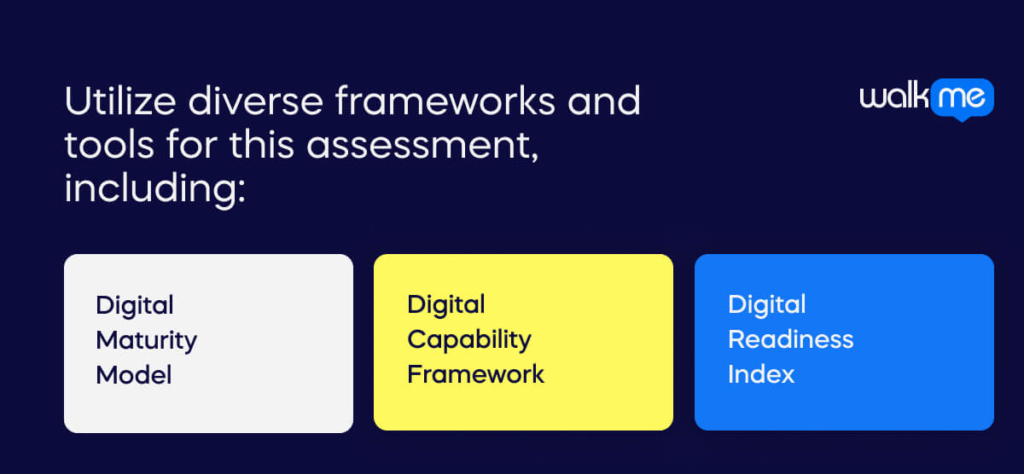
Utilize diverse frameworks and tools for this assessment, including:
- Digital Maturity Model.
- Digital Capability Framework.
- Digital Readiness Index.
These tools serve as benchmarks, allowing you to compare your digital capabilities with industry standards, best practices, and competitors. Additionally, they assist in pinpointing strengths and weaknesses, identifying gaps and opportunities, and assessing risks and challenges within your digital landscape.
Craft your digital roadmap
Following the digital maturity assessment, the subsequent step involves formulating your digital roadmap. This strategic plan delineates the path toward realizing digital goals, enhancing digital maturity, and surmounting digital challenges.
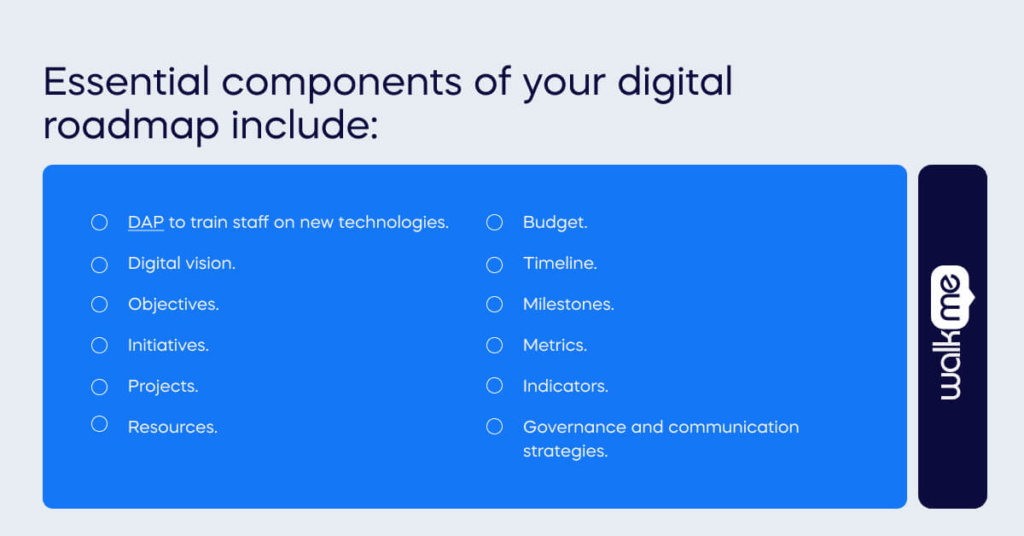
Essential components of your digital roadmap include:
- DAP to train staff on new technologies.
- Digital vision.
- Objectives.
- Initiatives.
- Projects.
- Resources.
- Budget.
- Timeline.
- Milestones.
- Metrics.
- Indicators.
- Governance and communication strategies.
Ensure your digital roadmap is pragmatic, adaptable, and aligned with your overarching business strategy.
Put your digital solutions into action
Moving to the fourth phase involves the implementation of your digital solutions. This step encompasses executing your digital roadmap, delivering digital projects, and deploying digital technologies.
Employ agile and user-centric methodologies for designing, testing, and iterating digital solutions. Engage stakeholders, including customers, employees, partners, and suppliers, throughout the digital implementation process.
Monitor and assess digital outcomes, feedback, and lessons learned. Celebrate digital successes and acknowledge individuals who championed digital initiatives.
Cultivate your digital culture
In conclusion, the process involves cultivating a digital culture and establishing a supportive environment for digital transformation and innovation. Encourage a digital mindset characterized by attitudes and behaviors that embrace change, learning, collaboration, and experimentation.
Develop a digital skillset encompassing competencies and capabilities for utilizing, creating, and managing digital solutions.
Construct a digital ecosystem, forming a network of relationships and resources that bolster and enrich your digital capabilities. These steps allow you to gauge and enhance your company’s digital readiness, paving the way for innovation and competitiveness in the digital era.
Use a digital readiness assessment to reduce waste
Organizations crave a game-changing catalyst — a powerhouse strategy fueled by digital technologies and data is the key to unlocking streamlined digital workflows.
It’s not just a tool; it’s a transformative initiative that defines a cultural shift, unveiling undiscovered revenue streams propelling businesses towards heightened efficiency, increased productivity, and fortified profitability.
At its core, this evolution hinges on the strategic integration of digital readiness assessments.
Imagine a solution that pinpoints inefficiencies and eradicates them, minimizing wastage along the way. Digital readiness doesn’t just evaluate technological prowess; it measures the enthusiasm of your workforce to ride the digital wave. It is the most pivotal step in refining operations and will be a litmus test for your team’s preparedness to navigate the fast-paced tech game.
Highlighting potential obstacles clears the path for custom training programs, molding a workforce adept at navigating digital evolution. Resistance to change becomes a thing of the past, resulting in a smooth transition to digitalization and a finely optimized operational engine, shedding any unnecessary baggage in the process.
In the C-suite, where decisions mold destinies, implementing these digital readiness assessments is a strategic move that ensures a seamless transition to digitalization while curbing wastage within the intricate folds of organizational processes.

